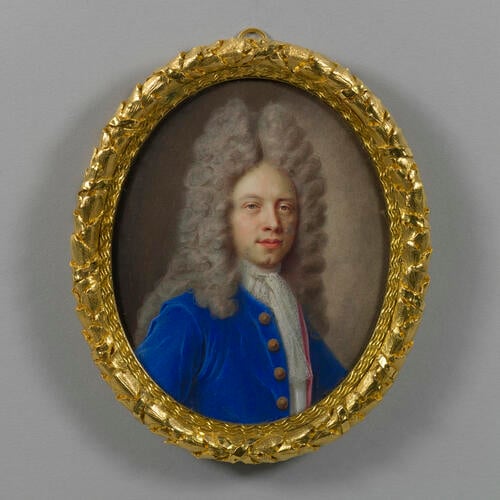-
1 of 253523 objects
John Christopher Pepusch (1667-1752) c.1710-15
Watercolour on vellum | 7.2 x 5.8 cm (sight) (sight) | RCIN 420160
-
This miniature may have been painted at the time John Christopher Pepusch received his degree from Oxford in 1713. His face is disfigured by pigment discolouration. It is one of three known portraits of Pepusch: his portrait by Thomas Hudson is in the National Portrait Gallery and another is in the Faculty of Music at Oxford. Pepusch was born in Berlin and arrived in London around 1700 to work in the Drury Lane orchestra. In 1708, he joined the opera company at the new Queen's theatre in Haymarket and, in 1714, transferred to the Theatre Royal, Drury Lane. He was appointed 'Master of the Music' at Cannons, the home of the Duke of Chandos, in early 1719 with a salary of £25 per quarter. He worked closely with John Gay and composed the overtures for The Beggar's Opera (1728) and The Wedding (1729). In 1726, Pepusch was one of the founders of the Academy of Ancient Music, which became the main focus of his activities, and he was its director until 1751. In December 1737, he became organist of the Charterhouse (an almshouse and school) and moved to an apartment in the grounds. His increasing interest in the music of the ancients led to his election as a fellow of the Royal Society in 1745. He died in his rooms at the Charterhouse on 20 July 1752 and was buried three days later in the chapel there. George Shelvocke, to whom Pepusch bequeathed this miniature, was secretary to the General Post Office and also a fellow of the Royal Society.
The artist, Benjamin Arlaud, was probably born in Geneva around 1670. He and his brother, Jacques Antoine, came from a family of clockmakers. Not many miniatures can be attributed to him with certainty but his work was of a high quality and he often delineated the eyebrows, upper eyelids and the corners of the eyes with red and shaded the face with greenish grey. He used a careful hatching technique (using close parallel lines) to define areas of light and shade. George Vertue, the engraver and antiquary, noted he was 'limner to the (King or Queen) till he died – whether he had Salary or not I can't tell' and described him as a 'Master of his Art'. The Royal Archives contain no record of appointment nor of any salary being paid.
The back of the eighteenth-century gilt locket preserved with the miniature is engraved: Jno Chrisr Pepusch Doctor of Music in the University of Oxford the Most Learned & as such the Most Excellent of his Profession. He Dyed in July 1752. Round the rim is also engraved: Bequeathed by his last will & testament to Geo. Shelvocke Esqr of ye General Post Office.
Catalogue entry adapted from Masterpieces in Little: Portrait Miniatures from the Collection of Her Majesty The Queen (1992)
Provenance
First recorded in the Royal Collection in 1870
-
Creator(s)
(artist) -
Medium and techniques
Watercolour on vellum
Measurements
7.2 x 5.8 cm (sight) (sight)
8.8 x 7.9 cm (frame, external)
Category
Object type(s)
Other number(s)
RL 1870 55.C.1
